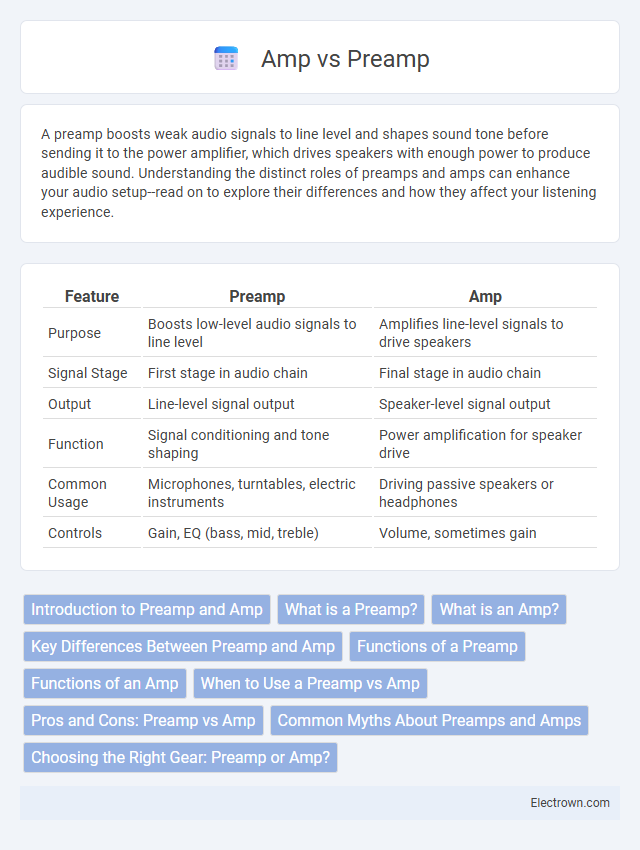A preamp boosts weak audio signals to line level and shapes sound tone before sending it to the power amplifier, which drives speakers with enough power to produce audible sound. Understanding the distinct roles of preamps and amps can enhance your audio setup--read on to explore their differences and how they affect your listening experience.
Table of Comparison
| Feature | Preamp | Amp |
|---|---|---|
| Purpose | Boosts low-level audio signals to line level | Amplifies line-level signals to drive speakers |
| Signal Stage | First stage in audio chain | Final stage in audio chain |
| Output | Line-level signal output | Speaker-level signal output |
| Function | Signal conditioning and tone shaping | Power amplification for speaker drive |
| Common Usage | Microphones, turntables, electric instruments | Driving passive speakers or headphones |
| Controls | Gain, EQ (bass, mid, treble) | Volume, sometimes gain |
Introduction to Preamp and Amp
A preamp boosts weak audio signals from devices like microphones or guitars, preparing them for further amplification and processing. An amp, short for amplifier, increases the power of these signals to drive speakers and produce sound at higher volumes. Understanding the distinction helps optimize your audio setup for clearer, more dynamic sound delivery.
What is a Preamp?
A preamp, or preamplifier, is an electronic device that amplifies low-level audio signals to line level, making them strong enough for processing or further amplification. It plays a critical role in shaping the sound by boosting weak inputs from microphones, instruments, or turntables before sending the signal to a power amplifier. Unlike a power amp, which drives speakers, the preamp focuses on signal clarity, tone control, and noise reduction in the audio chain.
What is an Amp?
An amp, or amplifier, boosts the electrical signal from your audio source to a level powerful enough to drive speakers and produce sound. It increases the amplitude of audio signals, ensuring clear and dynamic sound output in various audio systems. Understanding the role of an amp helps you optimize your audio setup for better sound quality.
Key Differences Between Preamp and Amp
Preamp and amp serve distinct roles in audio systems; the preamp boosts low-level audio signals to a line-level signal, preparing it for amplification without adding significant power. The amplifier then increases the line-level signal's power, driving speakers or headphones with sufficient volume and clarity. Key differences include signal processing stage, power output capability, and their placement within the audio signal chain.
Functions of a Preamp
A preamp amplifies weak audio signals from sources like microphones or guitars to line level, prepping them for further amplification or processing. It shapes the tonal characteristics and controls gain, ensuring clarity and reducing noise before the signal reaches the power amp. Your audio system relies on the preamp for precision and fidelity in the initial sound stage.
Functions of an Amp
An amplifier (amp) primarily increases the power of audio signals, enabling your speakers to produce louder and clearer sound without distortion. It receives low-level signals from a preamp and boosts them to a level suitable for driving speakers efficiently. Understanding the functions of an amp is crucial for optimizing sound quality in any audio setup.
When to Use a Preamp vs Amp
A preamp is essential when you need to boost weak audio signals from microphones or instruments to line level for further processing, ensuring clarity and proper gain control. Use a power amp when driving speakers directly, as it provides the necessary wattage to produce audible sound at sufficient volume without distortion. Your choice depends on whether you're managing signal strength or output power within your audio setup.
Pros and Cons: Preamp vs Amp
A preamp amplifies low-level audio signals to line level and shapes tone, offering precise control over gain, EQ, and signal quality, but may introduce noise if not high-quality. An amp provides the main power amplification to drive speakers, delivering volume and tonal power, yet it often lacks detailed tonal shaping features found in preamps. Combining both units allows optimal sound tuning and power output, but standalone amps might limit sonic flexibility while standalone preamps require separate power amplification.
Common Myths About Preamps and Amps
Common myths about preamps and amps often confuse their distinct roles in audio setups, incorrectly suggesting that preamps boost sound volume as much as amplifiers. Preamps primarily shape tone and provide initial signal gain, while amplifiers significantly increase power to drive speakers. Understanding that Your audio quality depends on both components working together debunks the misconception that one can substitute the other for optimal sound performance.
Choosing the Right Gear: Preamp or Amp?
Choosing the right gear depends on your specific audio needs; a preamp boosts low-level signals and shapes tone before sending them to the power amp, which drives the speakers with high power. For studio setups, preamps provide precise control over sound coloration and gain staging, while full amps offer an all-in-one solution for live performances with integrated amplification. Understanding the role of each device helps optimize sound quality and ensure compatibility with other audio components in your system.
preamp vs amp Infographic

 electrown.com
electrown.com